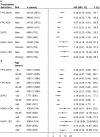Comparing different definitions of prediabetes with subsequent risk of diabetes: an individual participant data meta-analysis involving 76 513 individuals and 8208 cases of incident diabetes
- PMID: 31908797
- PMCID: PMC6936411
- DOI: 10.1136/bmjdrc-2019-000794
Comparing different definitions of prediabetes with subsequent risk of diabetes: an individual participant data meta-analysis involving 76 513 individuals and 8208 cases of incident diabetes
Abstract
Objective: There are currently five widely used definition of prediabetes. We compared the ability of these to predict 5-year conversion to diabetes and investigated whether there were other cut-points identifying risk of progression to diabetes that may be more useful.
Research design and methods: We conducted an individual participant meta-analysis using longitudinal data included in the Obesity, Diabetes and Cardiovascular Disease Collaboration. Cox regression models were used to obtain study-specific HRs for incident diabetes associated with each prediabetes definition. Harrell's C-statistics were used to estimate how well each prediabetes definition discriminated 5-year risk of diabetes. Spline and receiver operating characteristic curve (ROC) analyses were used to identify alternative cut-points.
Results: Sixteen studies, with 76 513 participants and 8208 incident diabetes cases, were available. Compared with normoglycemia, current prediabetes definitions were associated with four to eight times higher diabetes risk (HRs (95% CIs): 3.78 (3.11 to 4.60) to 8.36 (4.88 to 14.33)) and all definitions discriminated 5-year diabetes risk with good accuracy (C-statistics 0.79-0.81). Cut-points identified through spline analysis were fasting plasma glucose (FPG) 5.1 mmol/L and glycated hemoglobin (HbA1c) 5.0% (31 mmol/mol) and cut-points identified through ROC analysis were FPG 5.6 mmol/L, 2-hour postload glucose 7.0 mmol/L and HbA1c 5.6% (38 mmol/mol).
Conclusions: In terms of identifying individuals at greatest risk of developing diabetes within 5 years, using prediabetes definitions that have lower values produced non-significant gain. Therefore, deciding which definition to use will ultimately depend on the goal for identifying individuals at risk of diabetes.
Keywords: fasting blood glucose; glycated hemoglobin; incidence; pre-diabetes.
© Author(s) (or their employer(s)) 2019. Re-use permitted under CC BY. Published by BMJ.
Conflict of interest statement
Competing interests: CMYL, JAP, GW and RRH received grants from the National Health and Medical Research Council of Australia (NHMRC) during the conduct of the study; MW received person fees from Amgen and Hyowa Hakko Kirin outside the submitted work; RA received grants from NHMRC and the Hospital Research Foundation during the conduct of the study; JJJ received grants from National Institute of Health (NIH), National Institute of Diabetes and Digestive and Kidney Diseases (K23DK117041) during the conduct of the study; DJM and JES received grants from Commonwealth Department of Health and Aged Care, Abbott Australasia Pty Ltd, Alphapharm Pty Ltd, AstraZeneca, Aventis Pharmaceutical, Bristol-Myers Squibb Pharmaceuticals, Eli Lilly (Aust) Pty Ltd, GlaxoSmithKline, Janssen-Cilag (Aust) Pty Ltd, Merck Lipha s.a., Merck Sharp & Dohme (Aust), Novartis Pharmaceutical (Aust) Pty Ltd, Novo Nordisk Pharmaceutical Pty Ltd, Pharmacia and Upjohn Pty Ltd, Pfizer Pty Ltd, Sanofi Synthelabo, Servier Laboratories (Aust) Pty Ltd, the Australian Kidney Foundation and Diabetes Australia during the conduct of the study, and personal fees from AstraZeneca, Mylan, Boehringer Ingelheim, Sanofi, Merck Sharp and Dohme, Novo Nordisk and Eli Lilly outside the submitted work; PJS received grants from National Heart, Lung and Blood Institute during the conduct of the study; ES received grants from NIH during the conduct of the study.
Figures

References
-
- International Diabetes Federation IDF diabetes atlas. 18th edn Brussels: International Diabetes Federation, 2017.
-
- Australian Government Department of Health Australian National diabetes strategy 2016-2020. Canberra: Commonwealth of Australia, 2015.
-
- National Institute for Health and Care Excellence Type 2 diabetes prevention: population and community-level interventions. Public health guideline [PH35]. Available: https://www.nice.org.uk/guidance/ph35 [Accessed 18 Dec 2018].
Publication types
MeSH terms
Substances
Grants and funding
- N01 HC095168/HL/NHLBI NIH HHS/United States
- K23 DK117041/DK/NIDDK NIH HHS/United States
- N01 HC095167/HL/NHLBI NIH HHS/United States
- HHSN261201800010I/CA/NCI NIH HHS/United States
- HHSN268201800003I/HL/NHLBI NIH HHS/United States
- HHSN268201000051C/HL/NHLBI NIH HHS/United States
- HHSN268201500003I/HL/NHLBI NIH HHS/United States
- HHSN268201800015I/HB/NHLBI NIH HHS/United States
- N01 HC095162/HL/NHLBI NIH HHS/United States
- N01 HC095160/HL/NHLBI NIH HHS/United States
- HHSN268201500003C/HL/NHLBI NIH HHS/United States
- HHSN268201000041C/HL/NHLBI NIH HHS/United States
- HHSN268201800012I/HB/NHLBI NIH HHS/United States
- HHSN268201800012C/HL/NHLBI NIH HHS/United States
- N01 HC095161/HL/NHLBI NIH HHS/United States
- HHSN268201000031C/HL/NHLBI NIH HHS/United States
- HHSN268201800004I/HL/NHLBI NIH HHS/United States
- UL1 TR001079/TR/NCATS NIH HHS/United States
- N01 HC095169/HL/NHLBI NIH HHS/United States
- HHSN268201800014I/HB/NHLBI NIH HHS/United States
- HHSN268201800014C/HL/NHLBI NIH HHS/United States
- N01 HC095159/HL/NHLBI NIH HHS/United States
- HHSN268201800007I/HL/NHLBI NIH HHS/United States
- HHSN268201700002C/HL/NHLBI NIH HHS/United States
- HHSN268201800001C/HL/NHLBI NIH HHS/United States
- HHSN268201700001I/HL/NHLBI NIH HHS/United States
- HHSN268201800013I/MD/NIMHD NIH HHS/United States
- K24 DK106414/DK/NIDDK NIH HHS/United States
- HHSN268201700004I/HL/NHLBI NIH HHS/United States
- N01 HC095163/HL/NHLBI NIH HHS/United States
- HHSN268201800011C/HL/NHLBI NIH HHS/United States
- HHSN268201700005C/HL/NHLBI NIH HHS/United States
- HHSN268201700001C/HL/NHLBI NIH HHS/United States
- HHSN268201700003C/HL/NHLBI NIH HHS/United States
- HHSN268201700004C/HL/NHLBI NIH HHS/United States
- UL1 TR000040/TR/NCATS NIH HHS/United States
- N01 HC095166/HL/NHLBI NIH HHS/United States
- HHSN268201700002I/HL/NHLBI NIH HHS/United States
- HHSN268201800010I/HB/NHLBI NIH HHS/United States
- HHSN268201700005I/HL/NHLBI NIH HHS/United States
- HHSN268201800011I/HB/NHLBI NIH HHS/United States
- HHSN268201800005I/HL/NHLBI NIH HHS/United States
- N01 HC095165/HL/NHLBI NIH HHS/United States
- N01 HC095164/HL/NHLBI NIH HHS/United States
- HHSN268201700003I/HL/NHLBI NIH HHS/United States
- HHSN268201800006I/HL/NHLBI NIH HHS/United States
LinkOut - more resources
Full Text Sources
Medical
